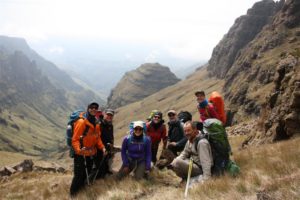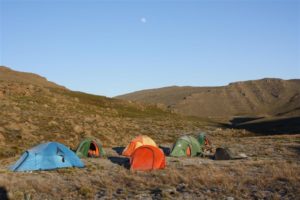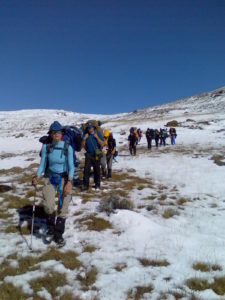Mini Traverse
The Mini Traverse is the hike from Mont-aux-Sources to Cathedral Peak in the Drakensberg mountain range of South Africa. This distance is approximately 80kms. Its is also one of the world’s most famous hiking routes and appears is several coffee-table books. It is so named the Mini Traverse, as it is the short version of the much longer Grand Traverse, which goes all the way to Bushman’s Nek in the south, 220kms distant. (See our Drakensberg map.) Peak High Mountaineering guides the Mini Traverse, usually in 5 days and 4 nights hiking. Hikers see the Tugela Falls, Monte-aux-Sources and the ever-famous Cathedral Peak. There are also views of Champagne Castle and Giant’s Castle to the south. The Tugela Falls are the world’s second highest waterfall at around 850m. 
The route is variable and there are no notice boards or dedicated indicators of the way to go. In places there are shepherd’s paths, which happen to be taking the correct line of travel and should be used as they make for easier walking. Most of the hike is along the Lesotho plateau at approximately 3000m altitude.
Fitness and experience
It goes without saying that to do the Mini Traverse requires good fitness and prior experience at hiking long distances in remote mountains. The weight of backpacks will be about 15-18kgs and need to be of 60 liters to 80 liters in size. Hikers need to walk for about 6-7 hours each day over rough alpine grass and rock. The route also traverses over high ridges on every day of the walk. It is possible to have bad weather, including high winds, snow and rain at any time of the year.
Porters
To reduce weight it is possible to hire porters. These strong Zulu men who live in the Mweni valley area will carry up to 13kgs of clients equipment. Note that the 13kgs includes the weight of items such as tents, stoves, gas canisters and sleeping bags. This means that on average if one porter is hired to carry equipment for one client, the client still carries about 10-12 kgs of weight and requires a rucksack of about 50litres. Porters arrive fully equipped and with their own food. If wanting a porter, this must be arranged well in advance and would usually be done by Peak High Mountaineering. 
Drinking water
The water, which is found in the high streams and rivers of the Drakensberg, is all perfectly suitable for drinking. No filters or chemicals are required prior to drinking.
Weather
The hike can be done at any time of year, however it is commonly done during the months of April or May, as this is usually the most stable weather in the Drakensberg. Doing it in July or August is very cold and snowfalls or deep snow on the ground could hinder progress. In the months of December to March there can be the possibility of heavy rain and thunderstorms. High winds are also possible during the months of July to October.
Access permits, fees and rescue
Access is at Sentinel car park. The area from Sentinel Car Park, and all the way to the chain ladders is owned by the Batlokoa Traditional Authority, which in turn is managed by the Transfrontier Parks Destination Company who also runs the Witsieshoek Mountain Lodge and the Car Park Hut.
A register is also located at the office, which should be filled in accurately. Note the following: After about 2 hrs walking one actually crosses into Ezemvelo/ KZNWildlife land at the top of the chain ladders. Then just past the Tugela Falls the route enters Lesotho and hikers are then either in Lesotho or South Africa until reaching the top of Mlambonja Pass when the route re-enters South Africa and Ezemvelo land once again. Passports are not usually carried, as this is a very remote area and there are no border posts.
If an emergency occurs, then the normal procedure of dialing 0800 005133 and asking for “mountain rescue” applies.
Accommodation
It is recommended to stay at the Witsieshoek Mountain Lodge the night before setting off on the hike the next morning. The lodge has accommodation from luxury chalet to hikers-rooms. Ask Peak High about cost options.
Shuttle services
There are shuttle services between the airport in Pietermaritzburg and Durban King Shaka International to Wistieshoek Mountain Lodge. Then there are shuttle services from the end of the hike back to the airports or other destinations. Exactly what shuttle is used depends on clients requirements and if they have a hired car or not. These shuttle services are outside contractors and not part of Peak High Mountaineering.
Wild camping
The Mini Traverse requires the use of lightweight mountain tents and caves for accommodation. The caves are huge overhangs of rock and can give good shelter from the elements.
Here we describe a route to be taken for the “Mini” in 5 days and 4 nights.
Day 1. Starting early from Sentinel car park (2596m) , take the main path up past the Sentinel to the chain-ladders. It is 2.5hrs to the large cairn on the escarpment above the last chain ladder (3029m). Next hike SE along the big path to view the Tugela Falls. From the falls, walk back south to the old Monte-aux-Sources hut and find a path, which leads up and over the ridge just to the east and then down to a small stream called the Bilanjil River. Carry straight on east till reaching the Kubedu River, cross this and up the valley opposite to the head of Ifidi Pass (3000m). Approx 14kms. Either camp in tents near the pass of go to Ifidi Cave.
Day 2. From near Ifidi Pass, go over the ridge to the south to Icidi Pass and then past Stimela Ridge, over another ridge to Fangs Pass. Camp in tents anywhere near the top of the pass. Approx 12kms. Fangs Cave is located a few hundred meters down the pass, is well sheltered but small and cramped and not recommended. Rate Hole Cave, which is also in this area, is also not recommended
Day 3. From Fangs Pass stay near the escarpment edge and hike up past Rwanqa Pass then onto a path up a ridge to overlook the Mweni Pinnacles (3222m). Stay on the path on the ridge and skirt around the Hanging Valleys until able to turn left and down another ridge towards the top of Mweni Pass. Cross above the summit pass and to the source of the Orange/Sengu River . Keep going along the escarpment edge and drop down a short and not-too-easy-to-find gully to Ledger’s Cave. This is one of the Drakensberg’s finest high altitude caves with amazing views of the valley below. Approx 17kms.
Day 4. Take a route directly across the wetlands above the cave to the top of Rockeries Pass and onto Nguza Pass. Midway between these two passes and right on the edge of the escarpment is a huge Cape Vulture Colony and is well worth a stop to view these magnificent birds. From Nuguza, follow the Koakoatsoan valley and over a high ridge. Descend this ridge down to the top of Ntonjelana Pass on a vague path and some small cliffs have to be scrambled down in places before reaching the valley, end of Map 1. Then up the Kwakwatsi River until opposite the Mlambonja Pass Approx 17kms. Camp in tents on this very pleasant river area.
Day 5. Climb out of the Kwakwatsi River and to the top of Mlambonja Pass (3006m). Cairns mark the entrance to the top of the pass, which is situated high on the escarpment ridge. Descend steeply down the first few hundred meters and then off left, through a narrow col and down to Twins Cave. The final day of the Mini can either be down Mlambonja Pass to the contour path and then out east to One-Tree-Hill and then descend to Cathedral Peak Hotel. However, the most spectacular way to end the “Mini” is to do the final day along the Bell-Twins Traverse route to Cathedral Peak and down via Orange Pell Gap. Both options end at Cathedral Peak Hotel gate (1380m).
For more information and bookings contact:
Gavin on 082 990 5876 or +27 (0) 33 343 3168 or gavin@peakhigh.co.za

 Follow
Follow